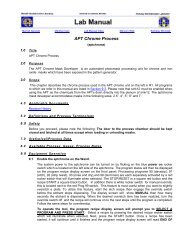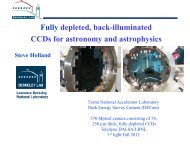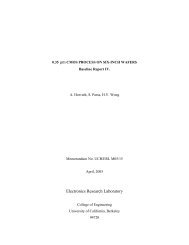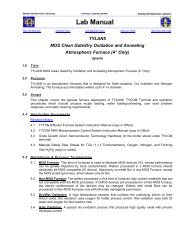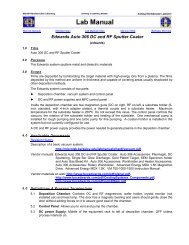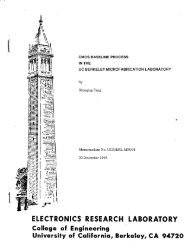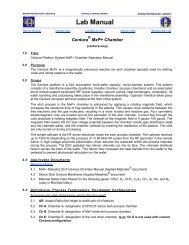Low Frequency Noise in Advanced MOS ... - Berkeley Microlab
Low Frequency Noise in Advanced MOS ... - Berkeley Microlab
Low Frequency Noise in Advanced MOS ... - Berkeley Microlab
Create successful ePaper yourself
Turn your PDF publications into a flip-book with our unique Google optimized e-Paper software.
<strong>Low</strong> <strong>Frequency</strong> <strong>Noise</strong> <strong>in</strong><br />
<strong>Advanced</strong> <strong>MOS</strong> Transistors<br />
Chia‐Yu Chen<br />
Department of Electrical Eng<strong>in</strong>eer<strong>in</strong>g<br />
Stanford University<br />
UC <strong>Berkeley</strong> EE298‐12 Solid State Technology and Device Sem<strong>in</strong>ar 2010‐11‐19
• C<strong>MOS</strong> scal<strong>in</strong>g<br />
It’s ok.<br />
It<br />
IEDM 2008 short course<br />
Motivation<br />
11/19/2010 C.‐Y. Chen UCB EE298‐12 Sem<strong>in</strong>ar<br />
<strong>Low</strong> <strong>Frequency</strong> <strong>Noise</strong> becomes important!<br />
It’s noisy.<br />
2
Motivation<br />
• <strong>Low</strong> <strong>Frequency</strong> (LF) noise<br />
IC designer<br />
Fabrication<br />
Device Material<br />
s<br />
LF noise<br />
11/19/2010 C.‐Y. Chen UCB EE298‐12 Sem<strong>in</strong>ar<br />
Physicist<br />
Mathematician<br />
3
• Introduction<br />
• Methodology<br />
• SiGe<br />
channel<br />
• Size effect<br />
• Conclusions<br />
Outl<strong>in</strong>e<br />
11/19/2010 C.‐Y. Chen UCB EE298‐12 Sem<strong>in</strong>ar<br />
4
• Introduction<br />
<br />
<br />
<br />
Why LF noise is important?<br />
The orig<strong>in</strong> of LF noise<br />
C<strong>MOS</strong> scal<strong>in</strong>g<br />
• Methodology<br />
• SiGe channel<br />
• Size effect<br />
• Conclusions<br />
Outl<strong>in</strong>e<br />
11/19/2010 C.‐Y. Chen UCB EE298‐12 Sem<strong>in</strong>ar<br />
5
S id (A 2 /Hz)<br />
Why LF noise is important?<br />
• <strong>Noise</strong> <strong>in</strong> a <strong>MOS</strong>FET<br />
10 2<br />
10 3<br />
10 4<br />
10 5<br />
<strong>Frequency</strong> (Hz)<br />
10 6<br />
11/19/2010 C.‐Y. Chen UCB EE298‐12 Sem<strong>in</strong>ar<br />
– White noise: thermal<br />
and shot noise.<br />
– 1/f noise:<br />
distribution<br />
<strong>in</strong> mobility.<br />
– G‐R noise:<br />
mechanism;<br />
case is RTN.<br />
noise<br />
certa<strong>in</strong> trap<br />
or fluctuation<br />
trap/de‐trap<br />
one special<br />
<strong>Low</strong> frequency (LF) noise<br />
6
• Analog doma<strong>in</strong><br />
Sid (uA 2 Sid (uA /Hz)<br />
2 /Hz)<br />
1E-3<br />
1E-4<br />
1E-5<br />
1E-6<br />
1E-7<br />
1E-8<br />
1E-9<br />
Worse oxide<br />
Why LF noise is important?<br />
1/f<br />
1E-10<br />
1 10 100<br />
<strong>Frequency</strong> (Hz)<br />
VCO: phase noise<br />
Good oxide<br />
Up‐convert<br />
– LF noise is up‐converted and causes phase noise.<br />
– Phase noise limits channel capacity.<br />
11/19/2010 C.‐Y. Chen UCB EE298‐12 Sem<strong>in</strong>ar<br />
Adjacent channel<br />
f0<br />
7
• Digital doma<strong>in</strong><br />
Why LF noise is important?<br />
N. Tega, VLSI symp. 2009, p. 50‐51.<br />
SRAM: noise<br />
marg<strong>in</strong><br />
– LF noise <strong>in</strong>creases with scal<strong>in</strong>g.<br />
– <strong>Noise</strong> marg<strong>in</strong> becomes small.<br />
11/19/2010 C.‐Y. Chen UCB EE298‐12 Sem<strong>in</strong>ar<br />
8
• Introduction<br />
<br />
<br />
<br />
Why LF noise is important?<br />
The orig<strong>in</strong> of LF noise<br />
C<strong>MOS</strong> scal<strong>in</strong>g<br />
• Methodology<br />
• SiGe channel<br />
• Size effect<br />
• Conclusions<br />
Outl<strong>in</strong>e<br />
11/19/2010 C.‐Y. Chen UCB EE298‐12 Sem<strong>in</strong>ar<br />
9
• Two schools<br />
The orig<strong>in</strong> of LF noise<br />
– Conductivity fluctuation.<br />
– Two schools: number<br />
fluctuations (Δμ).<br />
fluctuations<br />
11/19/2010 C.‐Y. Chen UCB EE298‐12 Sem<strong>in</strong>ar<br />
σ=μ N eff<br />
(ΔN)<br />
and<br />
mobility<br />
10
• ΔN model: one trap<br />
one trap/de‐trap<br />
G<br />
s D<br />
N+ N+<br />
A. McWhorter, Semi.<br />
Surf. Phys., 1957.<br />
The orig<strong>in</strong> of LF noise<br />
Surface effect<br />
11/19/2010 C.‐Y. Chen UCB EE298‐12 Sem<strong>in</strong>ar<br />
Random telegraph noise<br />
Lorentzian<br />
11
The orig<strong>in</strong> of LF noise<br />
• ΔN model: a lot of traps<br />
s D<br />
N+ N+<br />
A. McWhorter, Semi.<br />
Surf. Phys., 1957.<br />
G<br />
Correlated Δμ<br />
11/19/2010 C.‐Y. Chen UCB EE298‐12 Sem<strong>in</strong>ar<br />
2.07E-006<br />
Id (A)<br />
2.06E-006<br />
is also <strong>in</strong>duced.<br />
0 5 10 15<br />
Time (s)<br />
12
The orig<strong>in</strong> of LF noise<br />
• ΔN model: a lot of traps<br />
Gate (um)<br />
Gate (um)<br />
SISPAD 2006, Y. Liu<br />
F=1Hz<br />
Channel<br />
1e‐3<br />
Depth <strong>in</strong> oxide (um)<br />
F=1e4Hz<br />
Channel<br />
Depth <strong>in</strong> oxide (um)<br />
1e‐3<br />
Sid(A 2 /Hz)<br />
11/19/2010 C.‐Y. Chen UCB EE298‐12 Sem<strong>in</strong>ar<br />
1/f<br />
<strong>Frequency</strong> (Hz)<br />
– Sum of Lorentzians: 1/f noise<br />
13
S nt<br />
( r)<br />
2(<br />
G R)<br />
• ΔN model: I d<br />
S id /I d 2 (1/Hz)<br />
1e‐8<br />
The orig<strong>in</strong> of LF noise<br />
and V g<br />
1e‐9<br />
(1/Hz)<br />
1e‐10<br />
1e‐11<br />
Fix Vd and <strong>in</strong>crease (gm/Id)2<br />
Vg<br />
Dra<strong>in</strong> current (A)<br />
– Id: Sid/I 2<br />
d<br />
dependence<br />
α<br />
S id /I d 2 (1/Hz)<br />
S id /I d 2 (1/Hz)<br />
1E-8<br />
1E-9<br />
1E-10<br />
1E-11<br />
(gm/Id) 2 .<br />
– Vg: flat <strong>in</strong> weak <strong>in</strong>version.<br />
11/19/2010 C.‐Y. Chen UCB EE298‐12 Sem<strong>in</strong>ar<br />
0.0 0.5 1.0 1.5<br />
Gate Voltage (V)<br />
Gate voltage (V)<br />
14
• Δμ<br />
model<br />
– Bulk phonon scatter<strong>in</strong>g<br />
Source<br />
– Empirical equation<br />
T‐ED 1994, F. N. Hooge<br />
The orig<strong>in</strong> of LF noise<br />
Gate<br />
P+ P+<br />
N-type Si substrate<br />
S q<br />
<br />
I WLQ f<br />
Id H<br />
2<br />
d i<br />
Dra<strong>in</strong><br />
11/19/2010 C.‐Y. Chen UCB EE298‐12 Sem<strong>in</strong>ar<br />
S id (uA 2 /Hz)<br />
1E-3<br />
1E-4<br />
1E-5<br />
Bulk effect<br />
1/f<br />
1 10<br />
Phonon Si bulk<br />
Hooge mobility fluc.<br />
<strong>Frequency</strong> (Hz)<br />
15<br />
100
S nt<br />
( r)<br />
2(<br />
G R)<br />
S id /I d 2 (1/Hz)<br />
• Δμ<br />
1e‐8<br />
1e‐9<br />
model: I d<br />
1e‐10<br />
1e‐11<br />
The orig<strong>in</strong> of LF noise<br />
and V g<br />
S q<br />
<br />
I WLQ f<br />
Id H<br />
2<br />
d i<br />
Dra<strong>in</strong> current (A)<br />
– Id: Sid /I d 2<br />
– Vg: Sid/I 2<br />
d<br />
α<br />
dependence<br />
1/Id. S Sid /I 2<br />
id /I 2<br />
dd(1/Hz) (1/Hz)<br />
1E-7<br />
1E-8<br />
1E-9<br />
1E-10<br />
1E-11<br />
<strong>in</strong>creases when V g<br />
11/19/2010 C.‐Y. Chen UCB EE298‐12 Sem<strong>in</strong>ar<br />
-0.5 0.0 0.5 1.0 1.5 2.0<br />
Gate Voltage (V)<br />
Gate voltage (V)<br />
decreases.<br />
16
S id /I d 2 (A 2 /Hz)<br />
• ΔN or Δμ?<br />
G. Ghibaudo, <strong>Noise</strong> <strong>in</strong><br />
Devices and Circuits, 2003.<br />
The orig<strong>in</strong> of LF noise<br />
Dra<strong>in</strong> current (A)<br />
Sid /I 2<br />
S d (1/Hz)<br />
id /I 2<br />
d (A2 /Hz)<br />
– Different trend <strong>in</strong> I d<br />
1E-7<br />
1E-8<br />
1E-9<br />
1E-10<br />
1E-11<br />
and V g<br />
11/19/2010 C.‐Y. Chen UCB EE298‐12 Sem<strong>in</strong>ar<br />
Δμ<br />
Fix Vd and <strong>in</strong>crease Vg<br />
ΔN<br />
0.0 0.5 1.0 1.5 2.0<br />
Gate Voltage voltage (V) (V)<br />
dependence.<br />
17
• Introduction<br />
<br />
<br />
<br />
Why LF noise is important?<br />
The orig<strong>in</strong> of LF noise<br />
C<strong>MOS</strong> Scal<strong>in</strong>g<br />
• Methodology<br />
• SiGe channel<br />
• Size effect<br />
• Conclusions<br />
Outl<strong>in</strong>e<br />
11/19/2010 C.‐Y. Chen UCB EE298‐12 Sem<strong>in</strong>ar<br />
18
C<strong>MOS</strong> scal<strong>in</strong>g<br />
Size:<br />
Larger variability<br />
– C<strong>MOS</strong> scal<strong>in</strong>g: provide new opportunity to optimize LF noise.<br />
11/19/2010 C.‐Y. Chen UCB EE298‐12 Sem<strong>in</strong>ar<br />
19
• Introduction<br />
• Methodology<br />
<br />
<br />
<br />
Overview<br />
TCAD simulations<br />
<strong>Noise</strong> characterization<br />
• SiGe channel<br />
• Size effect<br />
• Conclusions<br />
Outl<strong>in</strong>e<br />
11/19/2010 C.‐Y. Chen UCB EE298‐12 Sem<strong>in</strong>ar<br />
20
Overview<br />
TCAD<br />
simulations<br />
<strong>Noise</strong><br />
characterization<br />
11/19/2010 C.‐Y. Chen UCB EE298‐12 Sem<strong>in</strong>ar<br />
Expla<strong>in</strong> low<br />
frequency noise<br />
mechanism<br />
21
• Introduction<br />
• Methodology<br />
<br />
<br />
<br />
Overview<br />
TCAD simulation<br />
<strong>Noise</strong> characterization<br />
• SiGe channel<br />
• Size effect<br />
• Conclusions<br />
Outl<strong>in</strong>e<br />
11/19/2010 C.‐Y. Chen UCB EE298‐12 Sem<strong>in</strong>ar<br />
22
TCAD simulation<br />
S =S id_total id_ ΔN<br />
– Total noise is the sum of ΔN and Δμ.<br />
– No correlation.<br />
11/19/2010 C.‐Y. Chen UCB EE298‐12 Sem<strong>in</strong>ar<br />
+S id_ Δμ<br />
23
TCAD simulation<br />
• Impedance field method (IMF)<br />
Vs<br />
W. Shockley, Quantum<br />
Theory of Atoms,<br />
Molecules and Solid State,<br />
1966, pp. 537–563.<br />
Vg<br />
Injection<br />
current<br />
11/19/2010 C.‐Y. Chen UCB EE298‐12 Sem<strong>in</strong>ar<br />
Voltage<br />
fluct. at<br />
dra<strong>in</strong><br />
Vd<br />
24
TCAD simulation<br />
• Impedance field method (IFM)<br />
Source<br />
Gate<br />
oxide<br />
Tride Saturation<br />
P<strong>in</strong>ch‐off<br />
IFM: l<strong>in</strong>ear No effect<br />
11/19/2010 C.‐Y. Chen UCB EE298‐12 Sem<strong>in</strong>ar<br />
Dra<strong>in</strong><br />
25
• ΔN model<br />
TCAD simulation<br />
oxide<br />
channel<br />
G‐R<br />
– <strong>Noise</strong> source is <strong>in</strong>side oxide.<br />
– A rate equation to correlate oxide traps and channel<br />
carriers and then apply IMF to calculate Sid. 11/19/2010 C.‐Y. Chen UCB EE298‐12 Sem<strong>in</strong>ar<br />
dra<strong>in</strong><br />
26
2<br />
( 1 <br />
n 2 D / <br />
c 0 )<br />
• Δμ<br />
model<br />
TCAD simulation<br />
S q<br />
Id<br />
2 H<br />
d i<br />
~1e-5 for Si material<br />
<br />
I WLQ f<br />
Extract from TCAD<br />
– Extract parameters from TCAD simulations such as Qi.<br />
11/19/2010 C.‐Y. Chen UCB EE298‐12 Sem<strong>in</strong>ar<br />
IEEE T‐ED 2008, C.‐Y. Chen<br />
27
• Introduction<br />
• The orig<strong>in</strong> of LF noise<br />
• Methodology<br />
<br />
<br />
<br />
Overview<br />
TCAD simulations<br />
<strong>Noise</strong> characterization<br />
• SiGe channel<br />
• Size effect<br />
• Conclusions<br />
Outl<strong>in</strong>e<br />
11/19/2010 C.‐Y. Chen UCB EE298‐12 Sem<strong>in</strong>ar<br />
28
• Basic schematic<br />
HP 4156<br />
<strong>Noise</strong> characterization<br />
Offset<br />
current<br />
DUT<br />
SR 570<br />
Signal<br />
analyzer<br />
A. Blaum, Agilent document, 2000.<br />
– Offset current removes the DC component at the <strong>in</strong>put.<br />
– SR570 is used to drive high impedance loads and <strong>in</strong>put impedance<br />
of signal analyzer should be high.<br />
11/19/2010 C.‐Y. Chen UCB EE298‐12 Sem<strong>in</strong>ar<br />
29
<strong>Noise</strong> characterization<br />
• Measurement bench<br />
Wafer (DUT)<br />
SR 570<br />
Dra<strong>in</strong><br />
Gate<br />
Source<br />
Bulk<br />
Cascade probe station HP4156<br />
11/19/2010 C.‐Y. Chen UCB EE298‐12 Sem<strong>in</strong>ar<br />
SR760 FFT spectrum analyzer<br />
30
• Introduction<br />
• Methodology<br />
• SiGe channel<br />
<br />
<br />
<br />
Device schematic<br />
Gate bias<br />
Body bias<br />
• Size effect<br />
• Conclusions<br />
Outl<strong>in</strong>e<br />
11/19/2010 C.‐Y. Chen UCB EE298‐12 Sem<strong>in</strong>ar<br />
31
• Si/SiGe/Si p‐HFET<br />
Si<br />
SiGe<br />
Si<br />
– Two channels:<br />
channel.<br />
Device schematic<br />
Parasitic surface channel<br />
SiGe<br />
Gate<br />
SiO 2<br />
SiGe buried channel<br />
Source Lg=1um Dra<strong>in</strong><br />
Bulk<br />
buried<br />
Body<br />
Si/SiGe/Si p-<strong>MOS</strong>FET<br />
channel<br />
11/19/2010 C.‐Y. Chen UCB EE298‐12 Sem<strong>in</strong>ar<br />
and<br />
L/W=1um/10um<br />
oxide thickness=6nm<br />
Devices from Panasonic<br />
parasitic<br />
surface<br />
32
• Advantage<br />
Device schematic<br />
1E-22<br />
1 10 100 1000 10000<br />
– Improve LF noise: (1) longer tunnel<strong>in</strong>g distance and (2) smaller<br />
Coulomb <strong>in</strong>teraction.<br />
S id (A 2 /Hz)<br />
1E-18<br />
1E-19<br />
1E-20<br />
1E-21<br />
11/19/2010 C.‐Y. Chen UCB EE298‐12 Sem<strong>in</strong>ar<br />
W/L=10um/1um<br />
Vd=-0.5V<br />
|Vg|-|Vth|=0.3V<br />
<strong>Frequency</strong> (Hz)<br />
Si: TCAD<br />
Si: meas.<br />
Si/SiGe/Si: TCAD<br />
Si/SiGe/Si: meas.<br />
33
• Introduction<br />
• Methodology<br />
• SiGe channel<br />
<br />
<br />
<br />
Device schematic<br />
Gate bias<br />
Body bias<br />
• Size effect<br />
• Conclusions<br />
Outl<strong>in</strong>e<br />
11/19/2010 C.‐Y. Chen UCB EE298‐12 Sem<strong>in</strong>ar<br />
34
• Dual‐channel behavior<br />
1E-17<br />
1E-18<br />
1E-19<br />
Sid (A 2 /Hz)<br />
W/L=10um/1um<br />
Vd=-0.5V<br />
Vov=2V<br />
Si: TCAD<br />
Si: meas.<br />
Si/SiGe/Si: TCAD<br />
Si/SiGe/Si: meas.<br />
1E-20<br />
1 10 100 1000<br />
<strong>Frequency</strong> (Hz)<br />
Charge Density (C/m 2 )<br />
0.006<br />
0.004<br />
0.002<br />
Gate bias<br />
Si/SiGe/Si p-H<strong>MOS</strong><br />
Surf. charge<br />
Buried charge<br />
Vd=-0.1V<br />
0.000<br />
-2.5 -2.0 -1.5 -1.0 -0.5 0.0 0.5<br />
Gate voltage (V)<br />
1E-22<br />
1 10 100 1000 10000<br />
– When buried channel dom<strong>in</strong>ant LF noise is reduced.<br />
11/19/2010 C.‐Y. Chen UCB EE298‐12 Sem<strong>in</strong>ar<br />
1E-18<br />
1E-19<br />
1E-20<br />
1E-21<br />
Sid (A 2 /Hz)<br />
W/L=10um/1um<br />
Vd=-0.5V<br />
|Vg|-|Vth|=0.3V<br />
<strong>Frequency</strong> (Hz)<br />
Si: TCAD<br />
Si: meas.<br />
Si/SiGe/Si: TCAD<br />
Si/SiGe/Si: meas.<br />
35
• Vg dependence<br />
ΔN<br />
S id /I d 2 (1/Hz)<br />
1E-7<br />
1E-8<br />
1E-9<br />
1E-10<br />
1E-11<br />
Gate bias<br />
SiGe p-H<strong>MOS</strong><br />
Number fluc.<br />
Mobility fluc.<br />
Total noise<br />
Measurements<br />
Vd=-0.1V<br />
1E-12<br />
-2.5 -2.0 -1.5 -1.0 -0.5 0.0 0.5<br />
Gate Voltage (V)<br />
– Weak <strong>in</strong>version: Δμ<br />
– Medium/strong <strong>in</strong>version: ΔN<br />
11/19/2010 C.‐Y. Chen UCB EE298‐12 Sem<strong>in</strong>ar<br />
Δμ<br />
ΔN<br />
36
• I d<br />
dependence<br />
S id /I d 2 (1/Hz)<br />
10 -7<br />
10 -8<br />
10 -9<br />
10 -10<br />
10 -11<br />
10 -12<br />
10 -13<br />
10 -14<br />
10 -15<br />
10 -16<br />
Δμ<br />
Gate bias<br />
1E-9 1E-8 1E-7 1E-6 1E-5 1E-4<br />
Dra<strong>in</strong> Currrent (A)<br />
– Weak <strong>in</strong>version: Δμ<br />
SiGe p-H<strong>MOS</strong><br />
V d =-0.1V<br />
ΔN<br />
– Medium/strong <strong>in</strong>version: ΔN<br />
11/19/2010 C.‐Y. Chen UCB EE298‐12 Sem<strong>in</strong>ar<br />
10 7<br />
10 6<br />
10 5<br />
10 4<br />
10 3<br />
10 2<br />
10 1<br />
10 0<br />
10 -1<br />
10 -2<br />
(g m /Id) 2 (V -2 )<br />
37
• Introduction<br />
• Methodology<br />
• SiGe channel<br />
<br />
<br />
<br />
Device schematic<br />
Gate bias<br />
Body bias<br />
• Size effect<br />
• Conclusions<br />
Outl<strong>in</strong>e<br />
11/19/2010 C.‐Y. Chen UCB EE298‐12 Sem<strong>in</strong>ar<br />
38
• SiGe p‐HFET<br />
S id (A 2 /Hz)<br />
1E-20<br />
1E-21<br />
1E-22<br />
1E-23<br />
TCAD<br />
Vb =-0.4V<br />
V b =-0.2V<br />
V b =0V<br />
V b =0.2V<br />
Mea.<br />
Body bias<br />
V b =-0.4V<br />
V b =-0.2V<br />
V b =0V<br />
V b =0.2V<br />
SiGe p-H<strong>MOS</strong><br />
Vov=-0.3V<br />
Vd=-0.5V<br />
10 100 1000<br />
<strong>Frequency</strong> (Hz)<br />
reverse<br />
forward<br />
SISPAD 2007, C.‐Y. Chen<br />
– LF noise <strong>in</strong> SiGe p‐HFET has strong body bias dependence.<br />
11/19/2010 C.‐Y. Chen UCB EE298‐12 Sem<strong>in</strong>ar<br />
39
• SiGe p‐HFET<br />
Surf. Buried<br />
Hole density (cm -2 )<br />
1E15<br />
1E14<br />
forward<br />
Body bias<br />
Vov=-0.3V<br />
Vd=-0.5V<br />
Si cap layer<br />
SiGe channel<br />
1E13<br />
-0.4 -0.3 -0.2 -0.1 0.0 0.1 0.2<br />
Body bias (V)<br />
Si/SiGe/Si p-H<strong>MOS</strong><br />
TCAD simulation<br />
reverse<br />
Surf. Buried<br />
– Body bias changes carrier distribution <strong>in</strong> dual channels<br />
11/19/2010 C.‐Y. Chen UCB EE298‐12 Sem<strong>in</strong>ar<br />
T‐ED 2008, C.‐Y. Chen<br />
40
• SiGe p‐HFET<br />
less noisy<br />
S id (A 2 /Hz)<br />
1E-20<br />
1E-21<br />
Si/SiGe/Si p-H<strong>MOS</strong><br />
Vov=-0.3V<br />
Vd=-0.5V<br />
Body bias<br />
Si cap layer hole density<br />
Simulated Sid<br />
Measured Sid<br />
1E-22<br />
-0.4 -0.3 -0.2 -0.1 0.0 0.1 0.2<br />
forward<br />
Body bias (V)<br />
1E16<br />
1E15<br />
1E14<br />
reverse<br />
Surface carrier density (cm -2 )<br />
– FL noise is ma<strong>in</strong>ly from surface channel.<br />
11/19/2010 C.‐Y. Chen UCB EE298‐12 Sem<strong>in</strong>ar<br />
more noisy<br />
T‐ED 2008, C.‐Y. Chen<br />
41
• Si p‐FET<br />
S id (A 2 /Hz)<br />
1E-19<br />
1E-20<br />
1E-21<br />
Si p<strong>MOS</strong><br />
Vov=-0.3V<br />
Vd=-0.5V<br />
Body bias<br />
Mea.<br />
Vb =-0.4V<br />
V b =-0.2V<br />
V b =0V<br />
V b =0.2V<br />
TCAD<br />
Vb =-0.4V<br />
V b =-0.2V<br />
V b =0V<br />
V b =0.2V<br />
10 100 1000<br />
<strong>Frequency</strong> (Hz)<br />
– Si p‐<strong>MOS</strong> does not show body bias dependence.<br />
11/19/2010 C.‐Y. Chen UCB EE298‐12 Sem<strong>in</strong>ar<br />
SISPAD 2007, C.‐Y. Chen<br />
reverse<br />
forward<br />
42
• Introduction<br />
• Methodology<br />
• SiGe channel<br />
• Size effect<br />
<br />
<br />
<br />
Device schematic<br />
Mechanism<br />
Gate bias<br />
• Conclusions<br />
Outl<strong>in</strong>e<br />
11/19/2010 C.‐Y. Chen UCB EE298‐12 Sem<strong>in</strong>ar<br />
43
Device schematic<br />
• Scaled <strong>MOS</strong>FETs (small gate area)<br />
Cross view Top view<br />
α<br />
L/W=40nm/70nm<br />
oxide thickness~2.5nm<br />
Devices from G‐foundries<br />
– Only a few traps are <strong>in</strong>volved.<br />
– ΔN predicts RTN; Δμ<br />
11/19/2010 C.‐Y. Chen UCB EE298‐12 Sem<strong>in</strong>ar<br />
shows 1/f noise.<br />
44
• Introduction<br />
• Methodology<br />
• SiGe channel<br />
• Size effect<br />
<br />
<br />
<br />
Device schematic<br />
Mechanism<br />
Gate bias<br />
• Conclusions<br />
Outl<strong>in</strong>e<br />
11/19/2010 C.‐Y. Chen UCB EE298‐12 Sem<strong>in</strong>ar<br />
45
• Ig‐<br />
/ Id‐RTN<br />
A few trap/de‐trap<br />
G<br />
s D<br />
N+ N+<br />
– Two types: Ig‐RTN<br />
Mechanism<br />
Ig<br />
and Id‐RTN.<br />
11/19/2010 C.‐Y. Chen UCB EE298‐12 Sem<strong>in</strong>ar<br />
Time<br />
Id<br />
Time<br />
46
Electron mobility (cm 2 /Vs)<br />
• Where are traps?<br />
320<br />
280<br />
240<br />
200<br />
160<br />
120<br />
Mechanism<br />
High-k metal gate n<strong>MOS</strong>FET<br />
(HfO 2 /TiN)<br />
0.4 0.8 1.2 1.6 2.0 2.4<br />
Interfacial layer thickness (nm)<br />
– Traps should be <strong>in</strong>side high‐κ<br />
gate<br />
oxide.<br />
11/19/2010 C.‐Y. Chen UCB EE298‐12 Sem<strong>in</strong>ar<br />
x x<br />
x<br />
HfO 2<br />
SiON<br />
channel<br />
47
• Trap/de‐trap<br />
Et<br />
– Capture: V th<br />
– Emission:<br />
V th<br />
Mechanism<br />
Ef<br />
I g (A)<br />
I d (A)<br />
7.40E-012<br />
7.20E-012<br />
7.00E-012<br />
1.60E-006<br />
1.58E-006<br />
1.56E-006<br />
and TAT <strong>in</strong>crease I d<br />
and TAT decrease I d<br />
11/19/2010 C.‐Y. Chen UCB EE298‐12 Sem<strong>in</strong>ar<br />
charge trap<br />
(capture)<br />
Track each other<br />
charge de-trap<br />
(emission)<br />
de-trapped<br />
state<br />
trapped<br />
state<br />
0 10 20 30<br />
and I g<br />
Time (s)<br />
and I g<br />
48
• PBTI and RTN<br />
I d (A) or I g (A)<br />
1E-5<br />
1E-7<br />
1E-9<br />
1E-11<br />
1E-13<br />
Mechanism<br />
-0.4 -0.2 0.0 0.2 0.4 0.6 0.8 1.0<br />
V g (V)<br />
I g<br />
– Consistent with RTN results.<br />
11/19/2010 C.‐Y. Chen UCB EE298‐12 Sem<strong>in</strong>ar<br />
I d<br />
Before stress<br />
Positive stress<br />
Negative stress<br />
49
• Introduction<br />
• Methodology<br />
• SiGe channel<br />
• Size effect<br />
<br />
<br />
<br />
Device schematic<br />
Mechanism<br />
Gate bias<br />
• Conclusions<br />
Outl<strong>in</strong>e<br />
11/19/2010 C.‐Y. Chen UCB EE298‐12 Sem<strong>in</strong>ar<br />
50
Ig (A)<br />
• Ig‐RTN 6.4x10 -11<br />
6.0x10 -11<br />
5.6x10 -11<br />
5.2x10 -11<br />
3.6x10 -11<br />
3.2x10 -11<br />
2.0x10 -11<br />
1.8x10 -11<br />
1.6x10 -11<br />
– V g<br />
0 5 10 15 20 25<br />
Time (s)<br />
Gate bias<br />
Vg=1V<br />
Vg=0.9V<br />
Vg=0.8V<br />
<strong>in</strong>creases: Time <strong>in</strong> high‐I g<br />
11/19/2010 C.‐Y. Chen UCB EE298‐12 Sem<strong>in</strong>ar<br />
Et<br />
state <strong>in</strong>creases.<br />
Ef<br />
51
Id (A)<br />
• Id‐RTN: <strong>Low</strong> Vg<br />
2.30E-009<br />
2.25E-009<br />
2.20E-009<br />
2.15E-009<br />
2.10E-009<br />
2.05E-009<br />
Vd=10mV Vg=0.2V<br />
150 155 160 165 170<br />
Time (s)<br />
Gate bias<br />
Sid (A 2 /Hz)<br />
1E-19<br />
1E-20<br />
1E-21<br />
1E-22<br />
1E-23<br />
– Measurement still shows 1/f noise; Δμ<br />
11/19/2010 C.‐Y. Chen UCB EE298‐12 Sem<strong>in</strong>ar<br />
Vg=0.2V<br />
Vd=20mV<br />
Scaled n<strong>MOS</strong>FET<br />
L=50nm<br />
W=70nm<br />
1E-24<br />
0.01 0.1 1 10<br />
<strong>Frequency</strong> (Hz)<br />
1/f<br />
model is dom<strong>in</strong>ant.<br />
52
Id (A)<br />
Gate bias<br />
• Id‐RTN: High gm bias condition<br />
4.80E-007<br />
4.75E-007<br />
4.70E-007<br />
4.65E-007<br />
Vd=10mV Vg=570mV<br />
4.60E-007<br />
20 25 30 35<br />
Time (s)<br />
Sid (A 2 /Hz)<br />
1E-15<br />
1E-16<br />
1E-17<br />
1E-18<br />
1E-19<br />
1E-20<br />
– RTN and Lorentzian shape are observed<br />
11/19/2010 C.‐Y. Chen UCB EE298‐12 Sem<strong>in</strong>ar<br />
Vd=10mV<br />
Vg=570mV<br />
Scaled n<strong>MOS</strong>FET<br />
L=50nm<br />
W=70nm<br />
0.1 1 10<br />
<strong>Frequency</strong> (Hz)<br />
1/f 2<br />
<strong>in</strong> high gm region.<br />
53
Id(A)<br />
• Id‐RTN: High Vg<br />
8.42E-007<br />
8.40E-007<br />
8.38E-007<br />
8.36E-007<br />
8.34E-007<br />
8.32E-007<br />
8.30E-007<br />
8.28E-007<br />
8.26E-007<br />
Vd=10mV Vg=750mV<br />
0 10 20 30 40<br />
Time (s)<br />
Gate bias<br />
Sid (A 2 /Hz)<br />
1E-16<br />
1E-17<br />
1E-18<br />
1E-19<br />
1E-20<br />
Vd=10mV<br />
Vg=750mV<br />
Scaled n<strong>MOS</strong>FET<br />
L=50nm<br />
W=70nm<br />
0.1 1 10<br />
– 1/f noise is shown <strong>in</strong> a very scaled <strong>MOS</strong>FET: Δμ<br />
11/19/2010 C.‐Y. Chen UCB EE298‐12 Sem<strong>in</strong>ar<br />
<strong>Frequency</strong> (Hz)<br />
1/f<br />
is dom<strong>in</strong>ant.<br />
54
• Id‐RTN: summary<br />
1/f<br />
gm (1/ohm)<br />
2.0x10 -6<br />
1.6x10 -6<br />
1.2x10 -6<br />
8.0x10 -7<br />
4.0x10 -7<br />
0.0<br />
Δμ<br />
Gate bias<br />
Vd=10mV<br />
Scaled n<strong>MOS</strong><br />
L/W=50nm/70nm<br />
-0.4 0.0 0.4 0.8 1.2<br />
Vg (V)<br />
ΔN<br />
Δμ<br />
RTN<br />
1/f<br />
– RTN should be considered especially <strong>in</strong> high gm region.<br />
11/19/2010 C.‐Y. Chen UCB EE298‐12 Sem<strong>in</strong>ar<br />
55
• Id‐RTN: summary<br />
Sid/Id 2<br />
1/f<br />
gm (1/ohm)<br />
2.0x10 -6<br />
1.6x10 -6<br />
1.2x10 -6<br />
8.0x10 -7<br />
4.0x10 -7<br />
Freq<br />
0.0<br />
Δμ<br />
Gate bias<br />
Vd=10mV<br />
Scaled n<strong>MOS</strong><br />
L/W=50nm/70nm<br />
-0.4 0.0 0.4 0.8 1.2<br />
Vg (V)<br />
ΔN<br />
Δμ<br />
– RTN should be considered especially <strong>in</strong> high gm region.<br />
11/19/2010 C.‐Y. Chen UCB EE298‐12 Sem<strong>in</strong>ar<br />
Sid/Id 2<br />
1/f<br />
Lorentzian<br />
Sid/Id 2<br />
1/f<br />
Freq<br />
56<br />
Freq
• Introduction<br />
• The orig<strong>in</strong> of LF noise<br />
• Methodology<br />
• SiGe channel<br />
• Size effect<br />
• Conclusions<br />
<br />
<br />
<br />
Summary<br />
Contributions<br />
Future work<br />
Outl<strong>in</strong>e<br />
11/19/2010 C.‐Y. Chen UCB EE298‐12 Sem<strong>in</strong>ar<br />
57
Summary<br />
Bias SiGe H‐<strong>MOS</strong> (Lg~1um) Scaled <strong>MOS</strong> (Lg~40nm)<br />
Weak <strong>in</strong>version Δμ model is dom<strong>in</strong>ant. Δμ model is dom<strong>in</strong>ant.<br />
High gm region (~ Vdd/2) ΔN model is important;<br />
LF noise is mostly surface<br />
effect.<br />
High Vg condition<br />
ΔN is dom<strong>in</strong>ant <strong>in</strong> our<br />
device, but <strong>in</strong> general it<br />
can be technology<br />
dependence.<br />
11/19/2010 C.‐Y. Chen UCB EE298‐12 Sem<strong>in</strong>ar<br />
ΔN model becomes<br />
important; RTN should be<br />
considered.<br />
Δμ model is dom<strong>in</strong>ant<br />
58
The orig<strong>in</strong> of LF noise: (1)<br />
Methodology:<br />
Summary<br />
ΔN model and (2)<br />
Δμ<br />
model.<br />
TCAD simulations and noise measurements<br />
SiGe channel: Dual‐channel is<br />
frequency noise performance.<br />
important<br />
to<br />
expla<strong>in</strong><br />
the<br />
low<br />
Size effect: Ig‐RTN is directly related to physical trapp<strong>in</strong>g or de‐<br />
trapp<strong>in</strong>g and the Id‐RTN reflects sensitivity to charge trapp<strong>in</strong>g<br />
as determ<strong>in</strong>ed by gm. C<strong>MOS</strong> scal<strong>in</strong>g: provides a new opportunity for LF noise study.<br />
11/19/2010 C.‐Y. Chen UCB EE298‐12 Sem<strong>in</strong>ar<br />
59
Contributions<br />
Detailed LF noise mechanisms <strong>in</strong> SiGe p‐HFET are proposed.<br />
LF noise mechanisms <strong>in</strong> scaled <strong>MOS</strong>FETs are<br />
analyzed.<br />
measured<br />
and<br />
Other parts: (1) LF noise mechanisms <strong>in</strong> high‐κ <strong>MOS</strong>FET, (2)<br />
A LF noise compact model <strong>in</strong> SiGe p‐HFET, (3) l<strong>in</strong>earity of<br />
asymmetric channel dop<strong>in</strong>g for LD<strong>MOS</strong>, (4) l<strong>in</strong>earity <strong>in</strong> GaN<br />
HEMTs, and (5) asymmetric FET scal<strong>in</strong>g.<br />
11/19/2010 C.‐Y. Chen UCB EE298‐12 Sem<strong>in</strong>ar<br />
60
Future work<br />
Reth<strong>in</strong>k “device noise”<br />
“distortion” and<br />
“reliability”<br />
11/19/2010 C.‐Y. Chen UCB EE298‐12 Sem<strong>in</strong>ar<br />
61
Publications<br />
[1] C.‐Y. Chen, Q. Ran, H.‐J. Cho, A. Kerber, Y. Liu, M.‐R. L<strong>in</strong>, and R. W. Dutton, IRPS, 2011.<br />
[2] C.‐Y. Chen, C.‐C. Wang, Y. Ye, Y. Liu, Y. Cao, and R. W. Dutton, SASIMI, 2010.<br />
[3] C.‐Y. Chen, O. Tornblad, R. W. Dutton, IEEE Trans. on Microwave Theory and Techniques,<br />
Dec. 2009.<br />
[4] C.‐Y. Chen and R. W. Dutton, IEEE Design & Test of Computers, 2009.<br />
[5] C.‐Y. Chen, Y. Liu, J. Kim, R. W. Dutton, SISPAD 2009, Sept. 2009.<br />
[6] C.‐Y. Chen, O. Tornblad, R. W. Dutton, IEEE MTT‐S International Microwave Symposium<br />
Dig. (IMS), pp. 601‐604, 2009.<br />
[7] C.‐Y. Chen, Y. Liu, R. W. Dutton, J. Sato‐Iwanaga, A. Inoue, H. Sorada, SASIMI 2009,<br />
Sapporo, Japan, pp. 405‐409, March 2009.<br />
[8] C.‐Y. Chen, Y. Liu, R. W. Dutton, J. Sato‐Iwanaga, A. Inoue, H. Sorada, IEEE Trans.<br />
Electron Devices, July, 2008.<br />
[9] J. Kim, C.‐Y. Chen and R. W. Dutton, Journal of Computational Electronics, Jan. 2008.<br />
[10] C.‐Y. Chen, Y. Liu, R. W. Dutton, J. Sato‐Iwanaga, A. Inoue, H. Sorada, SASIMI, Sapporo,<br />
Japan, pp. 238‐241, Oct. 2007.<br />
[11] C.‐Y. Chen, Y. Liu, R. W. Dutton, J. Sato‐Iwanaga, A. Inoue, H. Sorada, Workshop on<br />
Compact Model<strong>in</strong>g (WCM) 2007, San Jose, USA, March 2007.<br />
[12] J. Kim, C.‐Y. Chen, R. W. Dutton, SISPAD, Nov. 2007.<br />
[13] J. Kim, C.‐Y. Chen, R. W. Dutton, Proc. of 12th International Workshop on<br />
Computational Electronics (IWCE), Oct. 2007.<br />
11/19/2010 C.‐Y. Chen UCB EE298‐12 Sem<strong>in</strong>ar<br />
62
Backup: L<strong>in</strong>earity analysis of lateral channel<br />
dop<strong>in</strong>g <strong>in</strong> RF power <strong>MOS</strong>FETs<br />
Chia‐Yu Chen<br />
Department of Electrical Eng<strong>in</strong>eer<strong>in</strong>g<br />
Stanford University<br />
UC <strong>Berkeley</strong> EE298‐12 Solid State Technology and Device Sem<strong>in</strong>ar 2010‐11‐19
• Introduction<br />
• Quasi‐1D structure<br />
• Realistic LD<strong>MOS</strong> structure<br />
• Conclusions<br />
Slide 64<br />
Backup: Outl<strong>in</strong>e
L<strong>in</strong>earity:<br />
Slide 65<br />
Backup: Introduction (1 of 2)<br />
ω ω<br />
<strong>Low</strong> distortion is one of the most important concerns for wireless<br />
communication systems.<br />
Analysis of the distortion generated by the device itself has been fairly limited.
Harmonic balance device simulations:<br />
A unique harmonic balance (HB) device simulator with the capability of<br />
<strong>in</strong>clud<strong>in</strong>g external circuitry is used.<br />
In the HB simulations, variations <strong>in</strong> device parameters are directly reflected<br />
<strong>in</strong> the f<strong>in</strong>al large signal RF performance.<br />
Slide 66<br />
Backup: Introduction (2 of 2)
Channel dop<strong>in</strong>g (cm -3 )<br />
1E18<br />
1E17<br />
1E16<br />
Slide 67<br />
Backup: Quasi‐1D structure (1 of 3)<br />
Device schematic:<br />
uniform 8e16 cm -3<br />
uniform 2e17 cm -3<br />
char. length 0.2um<br />
char. length 0.3um<br />
Gate<br />
Source Graded<br />
channel<br />
dop<strong>in</strong>g<br />
Dra<strong>in</strong><br />
0.0 0.1 0.2 0.3 0.4 0.5<br />
Lateral location (um)<br />
0.5um gate length, 30nm oxide<br />
thickness.<br />
Avoid 2D-effects.<br />
Very high source and dra<strong>in</strong><br />
dop<strong>in</strong>gs to avoid compensation<br />
effects at source and dra<strong>in</strong><br />
junctions.<br />
4 cases: 2 uniform dop<strong>in</strong>g and 2<br />
laterally graded.<br />
Test circuit consist<strong>in</strong>g of bias<br />
feeds and block<strong>in</strong>g capacitors on<br />
<strong>in</strong>put and output.
Gm 3 /Gm<br />
0<br />
Slide 68<br />
Backup: Quasi‐1D structure (2 of 3)<br />
gm3/gm:<br />
1.5 2.0 2.5 3.0 3.5<br />
Gate voltage (V)<br />
uniform 8e16cm -3<br />
uniform 2e17cm -3<br />
char. length 0.3um<br />
char. length 0.2um<br />
Different gm3/gm magnitudes for<br />
different cases.<br />
Devices were biased at gm3/gm<br />
m<strong>in</strong>ima, close to overall best<br />
l<strong>in</strong>earity.<br />
IM3dBc<br />
-25<br />
-30<br />
-35<br />
-40<br />
-45<br />
-50<br />
-55<br />
-60<br />
-65<br />
IM3:<br />
uniform 8e16cm -3<br />
uniform 2e17cm -3<br />
char. length 0.3um<br />
char. length 0.2um<br />
Freq.=10MHz<br />
-1.5 -1.0 -0.5 0.0<br />
Log 10 (V <strong>in</strong> )<br />
First data po<strong>in</strong>t correlates to<br />
magnitude of gm3/gm m<strong>in</strong>ima.<br />
Shorter char. length / lower<br />
uniform dop<strong>in</strong>g: higher IM3 at<br />
low <strong>in</strong>put power lower IM3 at<br />
high <strong>in</strong>put power.
Lateral electrical field (V/cm)<br />
4x10 5<br />
3x10 5<br />
2x10 5<br />
1x10 5<br />
0<br />
Slide 69<br />
Backup: Quasi‐1D structure (3 of 3)<br />
Field distribution:<br />
unifrom 8e16cm -3<br />
uniform 2e17cm -3<br />
char. length 0.3um<br />
char. length 0.2um<br />
Vg at gm3/gm m<strong>in</strong>.<br />
Vd: 2.0V<br />
0.0 0.1 0.2 0.3 0.4 0.5<br />
Lateral channel position (um)<br />
Graded cases more uniform<br />
field.<br />
Smaller uniform dop<strong>in</strong>g more<br />
uniform field.<br />
Uniform lateral field better<br />
l<strong>in</strong>earity at higher power.
Lateral channel dop<strong>in</strong>g (cm -3 )<br />
1E20<br />
1E19<br />
1E18<br />
1E17<br />
1E16<br />
1E15<br />
1E14<br />
Slide 70<br />
Backup: Realistic LD<strong>MOS</strong> (1 of 4)<br />
Device schematic (based on Inf<strong>in</strong>eon 7 th generation<br />
design):<br />
char. length 0.0525um<br />
char. length 0.0625um<br />
char. length 0.0725um<br />
char. length 0.0925um<br />
0.4 0.6 0.8<br />
Lateral channel location (um)<br />
Two different lightly doped dra<strong>in</strong><br />
regions: optimize on-resistance and<br />
breakdown voltage.<br />
Source dop<strong>in</strong>g and lightly doped<br />
dra<strong>in</strong> kept the same for all cases.<br />
Four different lateral grad<strong>in</strong>g cases <strong>in</strong><br />
channel, def<strong>in</strong>ed through analytical<br />
expressions.
Gm3/Gm1<br />
1.5<br />
1.0<br />
0.5<br />
0.0<br />
-0.5<br />
-1.0<br />
-1.5<br />
-2.0<br />
Slide 71<br />
Backup: Realistic LD<strong>MOS</strong> (2 of 4)<br />
gm3/gm:<br />
char. length 0.0525um<br />
char. length 0.0625um<br />
char. length 0.0725um<br />
char. length 0.0925um<br />
6.0 6.3 6.6 6.9 7.2 7.5<br />
Gate voltage (V)<br />
Bias-po<strong>in</strong>t at gm3/gm m<strong>in</strong>ima.<br />
Test circuitry:<br />
Circuitry with <strong>in</strong>ternal and external<br />
match<strong>in</strong>g and bias.<br />
Inf<strong>in</strong>eon product PTF210451.
IM3dBc<br />
Slide 72<br />
-30<br />
-40<br />
-50<br />
-60<br />
Backup: Realistic LD<strong>MOS</strong> (3 of 4)<br />
IM3 at 2.14GHz:<br />
char. length 0.0525um<br />
char. length 0.0625um<br />
char. length 0.0725um<br />
char. length 0.0925um<br />
Freq. = 2.14GHz<br />
0.0 0.5<br />
Log10(V<strong>in</strong>)<br />
IM3dBc<br />
-30<br />
-40<br />
-50<br />
char. length 0.0525um<br />
char. length 0.0625um<br />
char. length 0.0725um<br />
char. length 0.0925um<br />
Freq. = 2.14GHz<br />
-60<br />
20 25 30 35 40<br />
Effect of graded dop<strong>in</strong>g is significant the nonl<strong>in</strong>earities <strong>in</strong> capacitances will<br />
not swamp the studied effects at high frequency.<br />
More graded channel profile shows better l<strong>in</strong>earity <strong>in</strong> the <strong>in</strong>termediate power<br />
regime.<br />
IM1
IM3dBc<br />
-30<br />
-40<br />
-50<br />
-60<br />
20 25 30 35<br />
Slide 73<br />
Backup: Realistic LD<strong>MOS</strong> (4 of 4)<br />
Vgs shifts from gm3/gm:<br />
char. 0.0525um; shift 50mv<br />
char. 0.0925um; shift -30mv<br />
char. 0.0525um; shift 0mv<br />
char. 0.0925um; shift -100mv<br />
Freq. = 2.14GHz<br />
IM1<br />
Vgs shifts from gm3/gm<br />
m<strong>in</strong>ima IM3 change is<br />
quite sensitive.<br />
Different device designs<br />
give different IM3 that<br />
cannot be compensated for<br />
by simply chang<strong>in</strong>g Vgs bias<br />
(Idq sett<strong>in</strong>g).
• A graded channel has better l<strong>in</strong>earity for <strong>in</strong>termediate to<br />
high powers. By contrast, for <strong>in</strong>creased back‐off, the<br />
situation is reversed.<br />
• Nonl<strong>in</strong>earities <strong>in</strong> <strong>in</strong>tr<strong>in</strong>sic capacitances will not swamp the<br />
effect of graded channel dop<strong>in</strong>g at high frequency.<br />
• The effect of graded channel dop<strong>in</strong>g cannot be fully<br />
compensated for by adjust<strong>in</strong>g the Idq bias po<strong>in</strong>t.<br />
• The analysis lays ground‐work for RF device optimization for<br />
improved l<strong>in</strong>earity.<br />
Slide 74<br />
Backup: Conclusions
Dra<strong>in</strong> current, log scale (A/um)<br />
1E-4<br />
1E-5<br />
1E-6<br />
1E-7<br />
1E-8<br />
1E-9<br />
1E-10<br />
1E-11<br />
1E-12<br />
0.0<br />
0 1 2 3 4<br />
Slide 75<br />
Backup: Additional <strong>in</strong>formation (1 of 4)<br />
Quasi-1D structure: IdVgs<br />
unifrom 8e16cm -3<br />
unifrom 2e17cm -3<br />
char. length 0.3um<br />
char. length 0.2um<br />
Vd=2.0V<br />
Gate voltage (V)<br />
2.0x10 -4<br />
1.8x10 -4<br />
1.6x10 -4<br />
1.4x10 -4<br />
1.2x10 -4<br />
1.0x10 -4<br />
8.0x10 -5<br />
6.0x10 -5<br />
4.0x10 -5<br />
2.0x10 -5<br />
Dra<strong>in</strong> current, l<strong>in</strong>ear scale (A/um)<br />
Gm 3 /Gm<br />
0<br />
1.5 2.0 2.5 3.0 3.5<br />
Gate voltage (V)<br />
uniform 8e16cm -3<br />
uniform 2e17cm -3<br />
char. length 0.3um<br />
char. length 0.2um<br />
Clearly different gm3/gm magnitudes for different cases.<br />
Shorter characteristic length and lower dop<strong>in</strong>g give larger gm3/gm<br />
magnitudes.<br />
Devices were biased at gm3/gm m<strong>in</strong>ima, close to overall best<br />
l<strong>in</strong>earity for many applications.
Gm3/Gm<br />
Quasi-1D structure: velocity saturation:<br />
0.0<br />
-0.5<br />
-1.0<br />
-1.5<br />
-2.0<br />
Slide 76<br />
Backup: Additional <strong>in</strong>formation (2 of 4)<br />
Uniform dop<strong>in</strong>g 2e17cm -3<br />
2.6 2.8 3.0 3.2 3.4 3.6<br />
Gate voltage (V)<br />
w/ Vsat model<br />
w/o Vsat model<br />
IM3dBc<br />
When Vsat model is not <strong>in</strong>cluded:<br />
-30<br />
-40<br />
-50<br />
-60<br />
-70<br />
Uniform dop<strong>in</strong>g 2e17cm -3<br />
-80<br />
-25 -20 -15 -10 -5 0 5 10<br />
IM1<br />
w/ Vsat model<br />
w/o Vsat model<br />
1. gm3/gm shifts to a smaller magnitude.<br />
2. IM3 is much lower, both <strong>in</strong>itially and for high powers.
IM3dBc<br />
-30<br />
-35<br />
-40<br />
-45<br />
-50<br />
-55<br />
-60<br />
-65<br />
Slide 77<br />
Backup: Additional <strong>in</strong>formation (3 of 4)<br />
Realistic LD<strong>MOS</strong>: IM3 at 10MHz<br />
Freq.=10MHz<br />
char. length 0.0525um<br />
char. length 0.0625um<br />
char. length 0.0725um<br />
char. length 0.0925um<br />
-1.4 -1.2 -1.0 -0.8 -0.6 -0.4 -0.2 0.0<br />
Log10(V<strong>in</strong>)<br />
IM3dBc<br />
-30<br />
-35<br />
-40<br />
-45<br />
-50<br />
-55<br />
-60<br />
-65<br />
Freq.=10MHz<br />
char. length 0.0525um<br />
char. length 0.0625um<br />
char. length 0.0725um<br />
char. length 0.0925um<br />
-10 -5 0 5 10 15 20<br />
First, separate nonl<strong>in</strong>earities <strong>in</strong> static IV from capacitive effects <br />
low freq. 10MHz.<br />
More graded channel profile shows better l<strong>in</strong>earity <strong>in</strong> <strong>in</strong>termediate<br />
power regime.<br />
IM1
IM3dBc<br />
-20<br />
-30<br />
-40<br />
-50<br />
-60<br />
-70<br />
-80<br />
-90<br />
Slide 78<br />
Backup: Additional <strong>in</strong>formation (4 of 4)<br />
Realistic LD<strong>MOS</strong>: two sweet spots<br />
Shift -50mV from gm3/gm m<strong>in</strong>.<br />
gm3/gm m<strong>in</strong>.<br />
-10 -5 0 5 10 15 20<br />
IM1<br />
At high power, the compress<strong>in</strong>g<br />
non-l<strong>in</strong>earity along the load-l<strong>in</strong>e<br />
will dom<strong>in</strong>ate; the curves merge.<br />
<strong>Low</strong>er Vgs two sweet-spots<br />
appear.<br />
Ids (A)<br />
Vds (V)
Backup: GaN GaN HEMT HEMT structure structure<br />
Lg=0.5um<br />
11/23/2010 GaN HEMT project 79
Id (A/um)<br />
0.0012<br />
0.0010<br />
0.0008<br />
0.0006<br />
0.0004<br />
0.0002<br />
Backup: Id‐Vgs, GaN HEMT<br />
TCAD simulation results<br />
w/o Hydrodynamics<br />
w/ Hydrodynamics<br />
0.0000<br />
-7 -6 -5 -4 -3 -2 -1 0 1<br />
Vg (V)<br />
Id (A/um)<br />
1E-3<br />
1E-4<br />
1E-5<br />
1E-6<br />
1E-7<br />
w/o Hydrodynamics<br />
w/ Hydrodynamics<br />
-5 -4 -3 -2 -1 0 1<br />
Vg (V)<br />
11/23/2010 GaN HEMT project<br />
80
Gm3/Gm1<br />
Backup: Gm3/Gm1, GaN HEMT<br />
40<br />
20<br />
0<br />
-20<br />
w/o Hydrodynamics<br />
w/ Hydrodynamics<br />
Gm3/Gm1 m<strong>in</strong>.:Vg=-4.9047V<br />
-5 -4 -3 -2<br />
Vg (V)<br />
11/23/2010 GaN HEMT project<br />
81
Id(A)<br />
Backup: L<strong>in</strong>earity, GaN HEMT<br />
1E-8<br />
1E-10<br />
1E-12<br />
1E-14<br />
1E-16<br />
Id1 at f1<br />
Id3 at 2f1-f2<br />
GaN HEMT<br />
Vd=28V<br />
Vg=-4.91V (Gm3/Gm1 m<strong>in</strong>.)<br />
0.01 0.1<br />
Vg(V)<br />
11/23/2010 GaN HEMT project 82
• ΔN model<br />
ΔN<br />
Backup: The orig<strong>in</strong> of LF noise<br />
one trap RTN<br />
time:<br />
freq.:<br />
a lot of traps 1/f noise<br />
11/19/2010 C.‐Y. Chen UCB EE298‐12 Sem<strong>in</strong>ar<br />
Id<br />
Sid/Id 2<br />
Time<br />
Freq<br />
time:<br />
freq.:<br />
Id<br />
Sid/Id 2<br />
83<br />
Time<br />
Freq
• Statistical results<br />
Backup: Statistics<br />
11/19/2010 C.‐Y. Chen UCB EE298‐12 Sem<strong>in</strong>ar<br />
About 12% <strong>MOS</strong>FETs<br />
RTN: 9% Ig‐RTN, 2%<br />
and 1% ‐RTN.<br />
Ig‐/Id I d<br />
show<br />
‐RTN,<br />
The statistical results are from<br />
1000 devices with the same<br />
technology and structures.<br />
84
Ig (A)<br />
• Ig‐RTN 6.4x10 -11<br />
6.0x10 -11<br />
5.6x10 -11<br />
5.2x10 -11<br />
3.6x10 -11<br />
3.2x10 -11<br />
2.0x10 -11<br />
1.8x10 -11<br />
1.6x10 -11<br />
– V g<br />
Backup: Gate bias<br />
0 5 10 15 20 25<br />
Time (s)<br />
Vg=1V<br />
Vg=0.9V<br />
Vg=0.8V<br />
<strong>in</strong>creases: Time <strong>in</strong> high‐I g<br />
<br />
10<br />
1<br />
0.1<br />
0.01<br />
11/19/2010 C.‐Y. Chen UCB EE298‐12 Sem<strong>in</strong>ar<br />
0.6 0.7 0.8 0.9 1.0 1.1 1.2<br />
state <strong>in</strong>creases.<br />
Vg (V)<br />
Device 1<br />
Device 2<br />
Device 3<br />
Device 4<br />
85
Backup: TCAD<br />
• Id‐RTN: High gm bias condition<br />
Trap/de-trap<br />
– TCAD simulations confirm the orig<strong>in</strong> of RTN can be from one‐<br />
trap/de‐trap.<br />
11/19/2010 C.‐Y. Chen UCB EE298‐12 Sem<strong>in</strong>ar<br />
86
Portable electronics<br />
Ultra‐low power circuits<br />
<br />
Backup: Motivation<br />
Transistor reliability<br />
<strong>Noise</strong>: key issue<br />
development.<br />
Integrated sensors<br />
Device <strong>Noise</strong><br />
for<br />
the<br />
future<br />
SRAM yield<br />
Bio‐implant system<br />
Bio/silicon <strong>in</strong>terfaces<br />
electronic<br />
system<br />
11/09/2010 C.‐Y. Chen UCB sem<strong>in</strong>ar<br />
87
U-shape<br />
Energy (eV)<br />
Backup: Trap distribution (1 of 2)<br />
L/H H/L<br />
Space (um)<br />
– Space: from gate to Si can be low-high or high-low.<br />
– Energy: distribution is a U-shape <strong>in</strong> log-scale.<br />
R. Jayaraman et al. IEEE T-ED, vol.36, no. 9, pp. 1773-1782, Sept., 1989.<br />
H. Wong et al. IEEE T-ED, vol.37 no. 7, pp. 1743-1749, July, 1990.<br />
11/19/2010 C.‐Y. Chen UCB EE298‐12 Sem<strong>in</strong>ar<br />
88
• V g<br />
flat<br />
Backup: Trap distribution (2 of 2)<br />
dependence<br />
– V g dependence shows flat region <strong>in</strong> weak <strong>in</strong>version regime.<br />
– In the U-shape distribution Vg dependence is less sensitive<br />
compared with uniform distribution.<br />
K. K. Hung et al. IEEE T-ED, vol.37, no. 5, pp. 1323-1333, May, 1990.<br />
Y. Liu et al. SISPAD 2006, pp. 99-102, 2006.<br />
∝<br />
1/V ov 2<br />
11/19/2010 C.‐Y. Chen UCB EE298‐12 Sem<strong>in</strong>ar<br />
89
Backup: Numerical method (1 of 2)<br />
– Physical model<br />
– Impedance field method (IMF)<br />
A k<br />
<br />
r Current fluctuatio n at kth electrode<br />
<br />
Injected current at r <strong>in</strong> the device<br />
2 ) <br />
S A dv<br />
<br />
( s<br />
r S r [5] A. McWhorter, Semiconductor Surface Physics, PA, Univ. Pennsylvania Press,1957, pp. 207-208.<br />
[6] W. Shockley et al., Quantum Theory of Atoms, Molecules and Solid State, NY: Academic, 1966, pp. 537-563.<br />
11/19/2010 C.‐Y. Chen UCB EE298‐12 Sem<strong>in</strong>ar<br />
<strong>in</strong><br />
90
Backup: Numerical method (2 of 2)<br />
• Hooge mobility fluctuation (Δμ<br />
– Bulk phonon scatter<strong>in</strong>g<br />
– Empirical equation<br />
– Numerical approach: Post process<br />
model)<br />
Hooge model is empirical the post process with simulated<br />
parameters/reasonable α H is used.<br />
[7] F. N. Hooge, IEEE T-ED, vol.41, no. 11, pp. 1926-1935, Nov., 1994.<br />
11/19/2010 C.‐Y. Chen UCB EE298‐12 Sem<strong>in</strong>ar<br />
91
Backup: Unified model (1 of 4)<br />
The fluctuat<strong>in</strong>g oxide charge density △Q ox is equivalent to a<br />
variation <strong>in</strong> the flat-band voltage<br />
The fluctuation <strong>in</strong> the dra<strong>in</strong> current yields<br />
Fluctuation of Num. Fluctuation of correlated mobility<br />
The first term <strong>in</strong> the parentheses is due to fluctuat<strong>in</strong>g number of<br />
<strong>in</strong>version carriers and the second term to correlated mobility<br />
fluctuations.<br />
11/19/2010 C.‐Y. Chen UCB EE298‐12 Sem<strong>in</strong>ar<br />
92
Backup: Unified model (2 of 4)<br />
The power spectral density of the flat-band voltage fluctuations<br />
is calculated by summ<strong>in</strong>g the contributions from all traps <strong>in</strong> the<br />
gate oxide.<br />
Fermi‐Dirac distribution<br />
z<br />
y<br />
Semiconductor<br />
11/19/2010 C.‐Y. Chen UCB EE298‐12 Sem<strong>in</strong>ar<br />
x<br />
93
Backup: Unified model (3 of 4)<br />
The product f(E)(1-f(E)) is sharply peaked around the quasi-<br />
Fermi level<br />
If the Fermi-level is far above or below the trap level, the trap<br />
will be filled or empty.<br />
f(E) 1-f(E)<br />
Fluctuations<br />
11/19/2010 C.‐Y. Chen UCB EE298‐12 Sem<strong>in</strong>ar<br />
All empty<br />
All filled<br />
94
Backup: Unified model (4 of 4)<br />
The trapp<strong>in</strong>g time constant<br />
(quantum tunnel<strong>in</strong>g)<br />
Tunnel<strong>in</strong>g attenuation length<br />
11/19/2010 C.‐Y. Chen UCB EE298‐12 Sem<strong>in</strong>ar<br />
Lorentzian spectrum<br />
95
• Numerical approach<br />
High-κ<br />
SiON<br />
j<br />
Different aff<strong>in</strong>ities and tunnel<strong>in</strong>g are<br />
considered<br />
Si<br />
Backup: High‐κ<br />
[9] Y. Liu et al. SISPAD 2006, pp. 99-102, 2006.<br />
11/19/2010 C.‐Y. Chen UCB EE298‐12 Sem<strong>in</strong>ar<br />
1/γ<br />
f=1Hz<br />
f=1e4Hz<br />
SiO 2 : 1×10 -8 cm<br />
HfO 2 : 2.1×10 -8 cm
Backup: <strong>Noise</strong> scal<strong>in</strong>g (1 of 2)<br />
• Scal<strong>in</strong>g trend: general trend<br />
– SiO 2 trap density is much smaller than that of HfO 2 .<br />
– 1/f noise <strong>in</strong>creases much faster than the thermal noise<br />
when size scales down.<br />
11/19/2010 C.‐Y. Chen UCB EE298‐12 Sem<strong>in</strong>ar<br />
97
Backup: <strong>Noise</strong> scal<strong>in</strong>g (2 of 2)<br />
• Scal<strong>in</strong>g trend: traps at gate edge<br />
– High trap density <strong>in</strong> the gate edge region.<br />
– In the scaled devices traps <strong>in</strong> the gate edge becomes<br />
important so S id /I d 2 <strong>in</strong>creases significantly.<br />
[14] Y. Yasuda et al., IEEE T-ED, vol.55, no. 1, pp. 417-422, Jan., 2008.<br />
11/19/2010 C.‐Y. Chen UCB EE298‐12 Sem<strong>in</strong>ar<br />
98
Backup: Halo dop<strong>in</strong>g<br />
– Halo dop<strong>in</strong>g profiles suppress the short channel effect.<br />
– The same amount of electrons greater Δ<br />
I d <strong>in</strong> halo.<br />
– Reduced <strong>in</strong>version carrier density <strong>in</strong> the halo regions.<br />
[8] Y. Liu et al. SISPAD 2006, pp. 99-102, 2006.<br />
11/19/2010 C.‐Y. Chen UCB EE298‐12 Sem<strong>in</strong>ar<br />
99
Backup: Metal gate<br />
Poly SiGe<br />
High-κ (TiN)<br />
– The lower<strong>in</strong>g of the 1/f noise: observed <strong>in</strong> the strong <strong>in</strong>version<br />
regime.<br />
– Traps and charges at the gate dielectric <strong>in</strong>terface: better<br />
screened by a metal gatealleviate remote phonon scatter<strong>in</strong>g.<br />
[15] E. Simoen et al., IEEE T-ED, vol.40, pp. 2054-2059, 1993.<br />
11/19/2010 C.‐Y. Chen UCB EE298‐12 Sem<strong>in</strong>ar<br />
+<br />
-<br />
-<br />
+<br />
100
Backup: SiGe FET (1 of 2)<br />
• Dual channel behavior<br />
– Surface and buried channels have<br />
different Coulomb <strong>in</strong>teractions.<br />
– Both channels also have different<br />
material quality.<br />
1E-20<br />
1E-21<br />
1E-22<br />
1E-23<br />
[16] C.-Y. Chen et al., IEEE T-ED, vol.55, no.7, pp. 1741-1748, 2008.<br />
11/19/2010 C.‐Y. Chen UCB EE298‐12 Sem<strong>in</strong>ar<br />
S id (A 2 /Hz)<br />
SiGe p-H<strong>MOS</strong><br />
Vd= -0.1V<br />
n 3-D<br />
w/o layer dependence<br />
This work<br />
Measurements<br />
-2.0 -1.5 -1.0 -0.5 0.0<br />
Gate Voltage (V)<br />
101
• Compact model<br />
Surface channel Buried channel<br />
Case 1: low Vg<br />
Vth_buried<br />
Vth_surf<br />
Case 3: High Vg<br />
Vg<br />
Si<br />
Case 2: Medium Vg<br />
Th<strong>in</strong> body <strong>MOS</strong><br />
SiGe<br />
Si<br />
Backup: SiGe FET (2 of 2)<br />
SiGe<br />
Si<br />
SiGe<br />
Si<br />
SiGe<br />
Si<br />
Vth_surf<br />
1E-10<br />
1E-11<br />
1E-12<br />
-2.0 -1.5 -1.0 -0.5 0.0 0.5<br />
– Physics based compact model can simulate dual-channel<br />
behavior for SiGe FETs.<br />
S id /I d 2 (1/Hz)<br />
1E-5<br />
1E-6<br />
1E-7<br />
1E-8<br />
1E-9<br />
1E-3<br />
1E-4<br />
1E-5<br />
1E-6<br />
1E-7<br />
1E-8<br />
11/19/2010 C.‐Y. Chen UCB EE298‐12 Sem<strong>in</strong>ar<br />
Sid (A 2 /Hz)<br />
10 7<br />
SiGe p-H<strong>MOS</strong><br />
Vd=-0.1V<br />
TCAD<br />
Proposed model<br />
Measurements<br />
Vg(V)<br />
SiGe p-H<strong>MOS</strong><br />
Si p-<strong>MOS</strong><br />
10 8<br />
<strong>Frequency</strong> (Hz)<br />
10 9<br />
102
Backup: Random Telegraph <strong>Noise</strong> (1 of 2)<br />
• Exponential tail <strong>in</strong> RTN<br />
– The slope of Vth <strong>in</strong>stability shows an exponential tail.<br />
– The slope <strong>in</strong>creases with technology scal<strong>in</strong>g.<br />
[18] A. Ghetti et al., IEEE T-ED, vol.56, no.8, pp. 1746-1752, 2009.<br />
11/19/2010 C.‐Y. Chen UCB EE298‐12 Sem<strong>in</strong>ar<br />
103
Backup: Random Telegraph <strong>Noise</strong> (2 of 2)<br />
• Body bias dependence: expla<strong>in</strong><br />
– RTN: channel/gate dielectrics system <strong>in</strong> dynamic equilibrium.<br />
– NBTI relaxation: perturbed system return<strong>in</strong>g to the equilibrium.<br />
11/19/2010 C.‐Y. Chen UCB EE298‐12 Sem<strong>in</strong>ar<br />
104
• Switched <strong>MOS</strong><br />
Backup: Switched bias<br />
– Large switch <strong>in</strong> gate can reduce 1/f noise.<br />
[19] A. P. Wel et al., IEEE JSSC, vol.42, no.3, pp. 540-550, 2007.<br />
11/19/2010 C.‐Y. Chen UCB EE298‐12 Sem<strong>in</strong>ar<br />
105
Backup: Temperature effect<br />
• RTN<br />
<br />
1/f noise<br />
[20] M. J. Deen et al. AIR conf. vol. 282, pp. 165-188, 1992.<br />
11/19/2010 C.‐Y. Chen UCB EE298‐12 Sem<strong>in</strong>ar<br />
106
Backup: 1/f noise characterization (1 of 4)<br />
SR 570 sett<strong>in</strong>gs<br />
– The sensitivity is 2uA/V<br />
– High bandwidth mode is used.<br />
<strong>Noise</strong> floor ~ 10 -10 Amps/rootHz Bandwidth ~ 1MHz<br />
11/19/2010 C.‐Y. Chen UCB EE298‐12 Sem<strong>in</strong>ar<br />
107
Backup: 1/f noise characterization (2 of 4)<br />
SR 760 sett<strong>in</strong>gs<br />
– Impedance ~ 1MΩ, 15pF<br />
– Bandwidth: DC to 100kHz<br />
– The bandwidth of noise measurement is limited by<br />
SR760.<br />
– Good for very low frequency measurements.<br />
11/19/2010 C.‐Y. Chen UCB EE298‐12 Sem<strong>in</strong>ar<br />
108
Backup: 1/f noise characterization (3 of 4)<br />
HP4396A <br />
– Impedance ~ 50Ω.<br />
– Bandwidth: 2Hz to 1.8GHz<br />
– Easy <strong>in</strong>terface and high<br />
resolution.<br />
11/19/2010 C.‐Y. Chen UCB EE298‐12 Sem<strong>in</strong>ar<br />
Active probe HP41800A<br />
– Impedance ~ 1MΩ.<br />
– Bandwidth: 5Hz to 500MHz<br />
– Convert high impedance to 50 Ω.<br />
109
Backup: 1/f noise characterization (4 of 4)<br />
On‐package measurements<br />
11/19/2010 C.‐Y. Chen UCB EE298‐12 Sem<strong>in</strong>ar<br />
110



